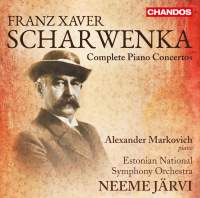SCHARWENKA Piano Concertos Nos 1 - 4
View record and artist detailsRecord and Artist Details
Composer or Director: (Franz) Xaver Scharwenka
Genre:
Orchestral
Label: Chandos
Magazine Review Date: 06/2014
Media Format: CD or Download
Media Runtime: 140
Mastering:
DDD
Catalogue Number: CHAN10814

Tracks:
| Composition | Artist Credit |
|---|---|
| Concerto for Piano and Orchestra No. 2 |
(Franz) Xaver Scharwenka, Composer
(Franz) Xaver Scharwenka, Composer Alexander Markovich, Piano Estonian National Symphony Orchestra Neeme Järvi, Conductor |
| Concerto for Piano and Orchestra No. 1 |
(Franz) Xaver Scharwenka, Composer
(Franz) Xaver Scharwenka, Composer Alexander Markovich, Piano Estonian National Symphony Orchestra Neeme Järvi, Conductor |
| Concerto for Piano and Orchestra No. 4 |
(Franz) Xaver Scharwenka, Composer
(Franz) Xaver Scharwenka, Composer Alexander Markovich, Piano Estonian National Symphony Orchestra Neeme Järvi, Conductor |
| Concerto for Piano and Orchestra No. 3 |
(Franz) Xaver Scharwenka, Composer
(Franz) Xaver Scharwenka, Composer Alexander Markovich, Piano Estonian National Symphony Orchestra Neeme Järvi, Conductor |
Author: Jeremy Nicholas
The problem with the newcomer is twofold: Chandos’s venue, the Estonia Concert Hall, Tallinn, has a touch of the empty aircraft hangar about it and sounds as if the microphones have been placed in the rear stalls; and Markovich, for all his technical ability and energetic industry, is a far less rhythmically incisive and refined player than Wild, Hamelin or Hough. For instance, compare the first pages of No 1, in which the soloist wrests attention from the forceful orchestral tutti by entering with equal force and più animato: Wild grabs the initiative in thrilling fashion; Markovich hesitates and immediately reduces the tension. In the sparkling Scherzo, the skittering left-hand run that introduces the second subject is just one example of passagework that is not clearly articulated. In the third movement, there is a misreading at 4'31", and the single C sharp that leads into the exultant final statement of the main theme has a crude augmented dominant chord added to it. The soloist’s final blaze of octaves in the coda is indistinguishable beneath the boisterous orchestra. Though Laurence Jeanningros is cautious and underpowered by comparison, she is at least precise and rhythmically secure, as well as being better recorded.
Markovich captures admirably the lyrical repose of the Second Concerto’s Chopinesque Adagio but is again bettered in the perky krakowiak-like finale by the crisper leggiero touch of Seta Tanyel, to say nothing of Raymond Lewenthal, who recorded only the finale, though in poorer sound. Tanyel is also to be preferred in Concerto No 3. Markovich redeems himself somewhat in the expansive (19'46") first movement of No 4 with some sensitive phrasing and touch. In the extraordinary tarantella finale, though, where Hough has you on the edge of your seat with dazzling derring-do, Markovich is hard-hitting and poorly organised, reducing the music to a noisy rant.
Discover the world's largest classical music catalogue with Presto Music.

Gramophone Digital Club
- Digital Edition
- Digital Archive
- Reviews Database
- Full website access
From £8.75 / month
Subscribe
Gramophone Full Club
- Print Edition
- Digital Edition
- Digital Archive
- Reviews Database
- Full website access
From £11.00 / month
Subscribe
If you are a library, university or other organisation that would be interested in an institutional subscription to Gramophone please click here for further information.




